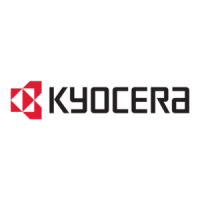1/JEIDA 4.2 [type I , memory card] ) A-1 Printer Specifications Item Power requirements Description FS-1750 120 V, 60 Hz, max. 5.8 A (U.S.A.
/Canada) 220240 V, 50 Hz/60 Hz, max. 3 A (European countries) Max. allowable voltage fluctuation: ±10% Max. allowable frequency fluctuation: ±2%.
Max.
667 W During sleeping 14 W During printing: LpA = 50 dB (A) LpA = 39 dB (A) During standby: During sleep mode: Immeasurably low FS-3750 120 V, 60
Hz, max. 7.8 A (U.S.A.
/Canada) 220240 V, 50 Hz/60 Hz, max. 4 A (European countries) Max. allowable voltage fluctuation: ±10% Max. allowable frequency fluctuation: ±2%.
Max. 898 W During sleeping 16 W During printing: LpA = 53 dB LpA = 39 dB During standby: During sleep mode: Immeasurably low Power consumption
Operating noise (in accordance with ISO 7779[Bystander Position, sound pressure level at the front]) Dimensions Weight 373 mm (14.7") wide × 310 mm
(12.2") high × 383 mm (15.1") deep (Excl. the paper tray) 14 kg (30 lb.
), main unit only A-2 B.1. General Guidelines Appendix B Paper Selection B.1. General Guidelines The printer is designed to print on high-quality copier
bond paper (the kind used in ordinary dry copier machines), but it can accept a variety of other types of paper as well within the limits specified below. The
manufacturer assumes no liability for problems that occur when paper not satisfying these requirements is used. Selection of the right paper is important. The
wrong paper can result in jams, misfeeds, curl, poor print quality, and paper waste, and in extreme cases can damage the printer. The guidelines given below
will increase the productivity of your office by ensuring efficient, trouble-free printing and reducing wear and tear on the printer. Paper Availability Most
types of paper are compatible with a variety of machines.
Paper intended for xerographic copiers can also be used with the printer. There are three general grades of paper: economy, standard, and premium. The
most significant difference between grades is the ease with which they pass through the printer. This is affected by the smoothness, size, and moisture content
of the paper, and the way in which the paper is cut. The higher the grade of paper you use, the less risk there will be of paper jam and other problems, and the
higher the level of quality your printed output will reflect.
Differences between paper from different suppliers can also affect the printer's performance. A high-quality printer cannot produce high-quality results when
the wrong paper is used. Low-priced paper is not economical in the long run if it causes printing problems. Paper in each grade is available in a range of
basis weights (defined later). The traditional standard weights are 16, 20, and 24 pounds (60g/m² to 90g/m²).
Paper Specifications The following table summarizes the basic paper specifications. Details are given on the following pages. Table B.1 Specifications Item
Weight Thickness Dimensional accuracy Squareness of corners Moisture content Direction of grain Pulp content Specification 60 to 90 g/m² (16 to 24
lbs./ream) 0.086 to 0.110 mm (3.4 to 4.3 mils) ±0.7 mm (±0.
0276 inches) 90° ±0.2° 4% to 6% Long grain 80% or more B-1 B.2. Selecting the Right Paper B.2. Selecting the Right Paper Laser printing is a process
involving laser light, electrostatic discharge, toner, and heat. In addition, as the paper passes through the printer it undergoes considerable sliding, bending,
and twisting motions. A highquality printing paper matching the printer's requirements withstands all these stresses, enabling the printer to turn out clean,
crisp printed copy consistently. Remember that all paper is not the same. Some of the factors to consider when selecting paper for the printer are as follows:
Condition of the Paper Avoid using paper that is bent at the edges, curled, dirty, torn, embossed, or contaminated with lint, clay, or paper shreds Use of paper
in these conditions can lead to illegible printing, misfeeding, and paper jams, and can shorten the life of the printer.
You're reading an excerpt. Click here to read official KYOCERA
FS-1750 user guide
http://somemanuals.com/dref/324820

